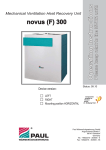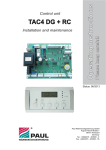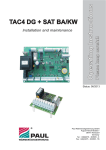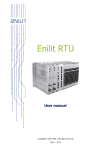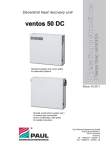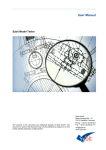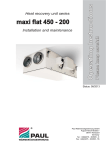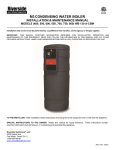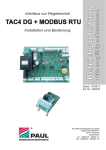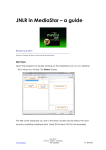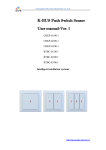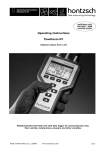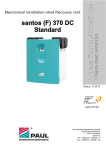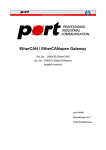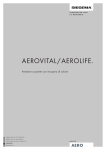Download user manual
Transcript
Device version: LEFT RIGHT Please keep next to the MVHR unit! focus (F) 200 Operating Instructions Mechanical Ventilation Heat Recovery Unit Status: 09.10 Components suitable for Passive House Dr. Wolfgang Feist Paul Wärmerückgewinnung GmbH August-Horch-Straße 7 08141 Reinsdorf Germany Tel.: +49(0)375 - 303505 - 0 Fax: +49(0)375 - 303505 - 55 Index 0 Preamble.................................................................................................................................... 3 1 Introduction............................................................................................................................... 3 1.1 CE Marking ................................................................................................................................. 3 1.2 1.2.1 1.2.2 1.2.3 Warranty and Liability ................................................................................................................. 4 General Information.................................................................................................................... 4 Warranty Terms.......................................................................................................................... 4 Liability........................................................................................................................................ 4 1.3 1.3.1 1.3.2 1.3.3 Safety.......................................................................................................................................... 4 Safety Instructions ...................................................................................................................... 4 Safety Appliances and Precautions............................................................................................ 5 Used Symbols ............................................................................................................................ 5 2 Notes for the User and the Installer........................................................................................ 5 2.1 2.1.1 2.1.2 2.1.3 2.1.4 2.1.5 2.1.6 2.1.7 Brief Description ......................................................................................................................... 5 Limitations of Use ....................................................................................................................... 5 Equipment Configuration ............................................................................................................ 5 Heat Exchanger.......................................................................................................................... 5 Fans............................................................................................................................................ 5 Filters .......................................................................................................................................... 6 Frost Protection .......................................................................................................................... 6 Common Operation with fireplaces ............................................................................................ 6 2.2 2.2.1 2.2.1.1 2.2.1.2 2.2.1.2.1 2.2.1.2.2 2.2.1.2.3 2.2.1.2.4 2.2.1.2.5 2.2.1.2.6 2.2.1.2.7 2.2.2 2.2.2.1 2.2.2.1.1 2.2.2.1.2 2.2.3 Available Control Units ............................................................................................................... 6 LED Control Panel...................................................................................................................... 6 Display of the Operation and Failure Conditions........................................................................ 7 Description of the Control Functions with the LED Control Panel.............................................. 8 Setup of the Operating Mode ..................................................................................................... 8 Fan Speeds ................................................................................................................................ 8 Boost ventilation Mode ............................................................................................................... 8 Filter Change .............................................................................................................................. 8 Configuration Mode for Joint Operation with a fire place ........................................................... 8 Configuration Mode Imbalance .................................................................................................. 9 Configuration of Frost Protection................................................................................................ 9 TFT Touchpanel ......................................................................................................................... 9 Description of the Operating Functions with the TFT Touchpanel ........................................... 10 Description of the Operating Functions of the Main Menu ....................................................... 10 Description of the Operating Functions of the Submenu ......................................................... 12 Boost ventilation switch ............................................................................................................ 17 2.3 2.3.1 2.3.1.1 2.3.2 Maintenance by the User.......................................................................................................... 17 Cleaning or Changing of the Filters.......................................................................................... 17 Changing of the Filters of the Device ....................................................................................... 17 What to Do in the Event of a Failure? ...................................................................................... 19 2.4 Proper Disposal ........................................................................................................................ 20 3 Notes for the Installer............................................................................................................. 21 3.1 Principal Configuration of the System ...................................................................................... 21 3.2 Configuration of the focus......................................................................................................... 21 3.3 Installation Requirements ......................................................................................................... 22 3.4 3.4.1 3.4.2 Installation of the focus............................................................................................................. 23 Transportation and Unpacking ................................................................................................. 23 Checking of the Scope of Delivery ........................................................................................... 23 3.5 Mounting of the focus ............................................................................................................... 23 1 3.5.1 3.5.2 3.5.3 3.5.4 3.5.5 3.5.5.1 3.5.5.2 Wall Mounting ........................................................................................................................... 23 Mounting on a Mounting Frame................................................................................................ 24 Connection of the Air Ducts ...................................................................................................... 25 Connection of the Condensate Drain ....................................................................................... 26 Electrical Connections .............................................................................................................. 27 Connection of the Adapter Board ............................................................................................. 27 Connection of the TFT Touchpanel .......................................................................................... 28 3.6 3.6.1 3.6.2 3.6.3 Commissioning of the focus ..................................................................................................... 28 Operational Readiness ............................................................................................................. 28 Adjustment of the Air Volume Flow .......................................................................................... 28 Adjustment of the Valves .......................................................................................................... 29 3.7 3.7.1 Menu Settings by the Installer / Service Staff........................................................................... 30 Setup Submenu ........................................................................................................................ 30 3.8 3.8.1 3.8.2 3.8.3 Maintenance and Repair by Qualified Personnel ..................................................................... 31 Inspection of the Condensate Drain ......................................................................................... 31 Cleaning of the Fans................................................................................................................. 32 Inspection and Cleaning of the Heat Exchanger ...................................................................... 32 3.9 Visualisation of Errors with the LED Control Panel .................................................................. 35 3.10 3.10.1 3.10.2 3.10.3 3.10.4 3.10.5 3.10.6 Visualisation of Errors with the TFT Touchpanel...................................................................... 35 Sensor Error of the Temperature Sensors T1…T4 .................................................................. 35 Threshold Error – Supply Air Temperature Too Low................................................................ 35 Threshold Error – Intake Air Temperature Too Low................................................................. 35 Fan Rotary Speed Error............................................................................................................ 36 Communication Error................................................................................................................ 36 Message – No External Release .............................................................................................. 36 Appendixes: Appendix 1: Circuit Diagram of the focus Appendix 2: Terminal Scheme of the Master Controller Appendix 3: Terminal Assignment of the Master Controller Appendix 4: Terminal Scheme of the Fan Slave Controller Appendix 5: Terminal Assignment of the Fan Slave Controller Technical Data Check List A Maintenance Works of the User Check List B Maintenance Works of Qualified Personnel Air Flow Report Commissioning and Handover Certificate EC Declaration of Conformity 2 0 Preamble Thank you for deciding on the heat recovery unit focus 200. The heat recovery unit focus 200 has been built according to the current state of the art and the acknowledged rules on safety. The device is subject to permanent improvement and development. Therefore, your device may differ slightly from the instructions. In order to guarantee a safe, appropriate and economic operation of the heat recovery unit focus 200, please observe and comply with all information and notes on safety in this operating manual. Subject of this operating manual is the heat recovery unit focus 200 in different design variants. Possible accessories are only described insofar as it is necessary for the appropriate operation. Please see the particular manuals for further information on accessories. The explanations in this operating manual are confined to the assembly, commissioning, operation, maintenance and the repair of failures of the heat recovery unit focus 200 and are addressed to appropriately trained personnel qualified for the particular work. If you have any questions that have not been answered or have not been sufficiently answered in this documentation, please contact the company PAUL Wärmerückgewinnung GmbH. We will be glad to help you. In addition to the general section, this manual consists of: • a section for the user and the installer; • a section especially for the installer. PLEASE READ THIS MANUAL CAREFULLY BEFORE INASTALLATION AND COMMISSONING! THIS MANUAL HAS BEEN MADE WITH GREATEST CARE. HOWEVER, NO RIGHTS CAN BE DERIVED THEREFROM. WE RESERVE THE RIGHT AT ANY TIME TO PARTIALLY OR ENTIRELY CHANGE THE CONTENT OF THIS MANUAL WITHOUT PRIOR NOTICE. 1 Introduction This section contains general information on the heat recovery unit focus 200. 1.1 CE Marking The device is called focus 200, hereinafter referred to as the focus. Focus is a ventilation device with heat recovery for a healthy, well-balanced and energy-saving ventilation of living spaces. Figure 1: Identification plate of the focus 3 1.2 1.2.1 Warranty and Liability General Information Our “general terms and conditions“ apply for the focus in the currently valid version. The warranty is aligned with the warranty terms of the manufacturer. This applies to mere replacement of the material and does not include the services. They apply only in case of proof of the performed maintenance according to our regulations by a skilled installer. 1.2.2 Warranty Terms The warranty period for our MVHR devices is two years as of delivery from our factory. Warranty claims can be asserted exclusively for material and/or construction defects, which occurred during the warranty period. In the event of a warranty claim, the focus may not be demounted without prior permission of the manufacturer in writing. The manufacturer grants the warranty for spare parts only when they were installed by a skilled installer. The warranty shall expire once/ when: • the warranty period has elapsed; • the device is operated without original PAUL filters; • parts are installed which were not delivered by the manufacturer; • the device is improperly used; • the defects occur due to incorrect connection, improper use or soiling of the system; • unauthorised changes or modifications on the plant are made. 1.2.3 Liability The focus was developed and manufactured for use in so-called comfort ventilation systems. Any other use is considered as “improper use” and can result in damages to the focus or in personal injuries, for which the manufacturer cannot be made liable. The manufacturer is not liable for any damage, which is due to the following causes: • Non-observance of the notes on safety, operation and maintenance, stated in this manual; • The installation was not performed according to the regulations; • Mounting of the spare parts, which were not delivered and prescribed by the manufacturer; • The defects occur due to incorrect connection, improper use or soiling of the system; • The warranty period has elapsed; • Normal wear. 1.3 1.3.1 Safety Safety Instructions Please always observe the safety instructions in this operating manual. The non-observance of the safety instructions, warning notices, notes and instructions can lead to injuries or damages to the focus. • Unless otherwise stated in this operating manual, only an authorised installer is entitled to install, connect, put into operation and maintain the focus; • The installation of the focus is to be performed according to the general local building, safety and installation instructions of the corresponding local authorities, of the water works and electric works and other official regulations and directives; • Always follow the safety instructions, warning notices, notes and instructions described in this operating manual; • Please keep this manual during the complete life time of the focus in proximity to the device; • The instructions for the regular replacement of the filters or the cleaning of the supply and exhaust air valves are to be strictly followed; • The specifications stated in this document may not be changed; • Any modification of the focus is prohibited; • In order to guarantee that the device will be regularly controlled, it is recommended to conclude a maintenance contract. Your supplier can give you the addresses of authorised installers in your area. 4 1.3.2 • • 1.3.3 Safety Appliances and Precautions The focus cannot be opened without tools; It must be excluded that the fans can be contacted with the hand. Therefore, air ducts must be connected to the focus. The minimum length of the pipelines is 900 mm. Used Symbols The following symbols are used in this manual: Caution, special note! Risk of: - injury of the user or the installer - damages to the device - impairment of the operation of the device if the instructions are not carried out properly 2 Notes for the User and the Installer This section describes how to handle focus. 2.1 2.1.1 Brief Description Limitations of Use The device is applicable for the ventilation in the living and office area (with restrictions in the industrial area) at air temperatures of -20°C to +40°C and normal air humidity. Any other type of use is considered as use for purposes other than intended. It is especially prohibited to use the device for the exhaustion of flammable and explosive gases. The installation is required in the frost-free area. For pre-heating of the outside air (in winter), an applicable plant-specific frost protection equipment should be connected upstream to the device. 2.1.2 Equipment Configuration The focus is designed and manufactured for controlled home ventilation. The focus 200 in the standard design has a patented reverse flow channel heat exchanger without moisture recovery. The device model focus (F) 200 is equipped with a membrane moisture heat exchanger. The compact ventilation device is designed for the wall fastening or on a mounting frame. The focus is delivered in the versions “RIGHT“ or “LEFT“. The design type is specified at the identification plate on the device. The housing consists of the coated sheet, the sidewalls in the colour anthracite, and the detachable hood in aluminium white. The internal lining made of high-quality polypropylene provides the necessary insulation and the device noise protection. 2.1.3 Heat Exchanger The highly efficient reverse flow channel heat exchanger (German and European patent) made of plastic is designed so that the exhaust air and supply air ducts are arranged in the chequer-board pattern and, therefore, a duplication of the heat exchange surface can be achieved towards the plate heat exchangers. With the moisture heat exchanger also humidity is transmitted besides the heat due to the chemical and physical properties of the heat exchanger membrane. The air types that flow past each other are divided for both types of heat exchangers. 2.1.4 Fans The focus includes two maintenance-free 230 VAC radial fans with the integrated power supply unit and electronic commutation. The volume flow constant fans keep the air quantity at a constant speed for each selected fan rotary speed. The air quantity is also not affected by soiled filters. 5 2.1.5 Filters 2 filters in Z design of the filter class G4 are installed in the device. They consist of a synthetic filter mat in a polypropylene frame. A pollen filter of the filter class F7 can be used as supply air filter. 2.1.6 Frost Protection The focus is equipped with automatic frost protection which prevents that the heat exchanger freezes at very low outside air temperatures. The fans will be temporarily deactivated if the intake air temperature or the supply air temperature of the device falls below the threshold value. 2.1.7 Common Operation with fireplaces The installer has to comply with the corresponding standards and regulations in case of synchronous operation with fireplaces, e.g. fireplace. The common operation of heat-producing appliances and ventilation systems dependent on the indoor air requires a suitable safety device (differential pressure switch) or a plant-specific device, when a dangerous negative pressure builds up in the installation room of the heat-producing appliance during the operation. The focus is prepared for the common operation with fireplaces. 2.2 Available Control Units The focus can be equipped with the following control units: • LED control panel • TFT Touchpanel • Boost ventilation switch 2.2.1 LED Control Panel Key - supply air and extract air mode Key – only extract air mode Key – only supply air mode Key – fan speed down Key - fan speed up Key - boost ventilation Reset key – filter change period Figure 2: Key assignment for LED control panel 6 2.2.1.1 Display of the Operation and Failure Conditions Figure 3: LED-display of the LED control panel Display L1 ... L7 lamp display L1 + L7 glow L8 glow L8 flashes Function / Meaning LED lamp display no LED = fan speed 0 (fan off, standby) 1 LED (L1) = fan speed 1 2 LEDs (L1+L2) = fan speed 2 ... etc. 7 LEDs (L1+…L7) = fan speed 7 L8 + L12 glow + L11 flashes 2x and then stays turned off No external release: fan off Supply air and extract air mode Error (sensor or frost protection): fan off Common error, the error number is displayed binary with the LEDs L1 to L7, see (Table 5 in chapter 3.9 Visualisation of Errors with the LED Control Panel) Configuration mode for common operation with a fireplace (Display only during the configuration phase) L9 L10 L10 Boost ventilation mode Pre-selected filter run-time has run out Pre-selected filter run-time will run out in less than 10 days L8 + L11 + L12 flash glows glows flashes L10 + L12 flashes Configuration mode imbalance for the selected fan speed (Display only during the configuration phase) L11 L11 glows flashes Extract air mode Extract air fan has failed: fan off L11 briefly flashes 3x Extract air mode deactivated (key “only extract air mode“ is blocked, configuration for common operation with fireplace is active) L12 L12 flashes flashes Supply air mode Supply air fan has failed: fan off Table 1: Assignment of functions of the LED displays 7 2.2.1.2 2.2.1.2.1 Description of the Control Functions with the LED Control Panel Setup of the Operating Mode The keys , , permit to set up the operating mode. The active operating mode is visualised by means of the respective LED of the operating mode key. 2.2.1.2.2 Fan Speeds / permit to select 7 fan speed. The current fan speed is displayed by means of a The keys LED lamp (L1 ... L7) up to selected speed inclusively. 2.2.1.2.3 Boost ventilation Mode With the key , the current ventilation mode is started with fan speed 7 for the duration of 15 minutes in the operating mode supply air and extract air operation. After the time for boost ventilation has expired, the control system activates the operating mode which has previously been preset. By means of the actuation of another functional key, the boost ventilation mode can be terminated at any time. The visualisation of the boost ventilation mode is realised by means of the flashing of the entire LED lamps and the LED L9 of the key . 2.2.1.2.4 Filter Change For the cyclic checking of the filters, an operating hours counter is integrated in the control system. The flashing LED L10 above the key indicates that the remaining run-time of the filters has elapsed. In case of a remaining run-time of the filters of less than 10 days, L10 briefly flashes at intervals of 3 sec. After carried out filter check and filter change, if necessary, the run-time of the filters is reset by pressing the key 2.2.1.2.5 for at least 3 sec. The LED L10 goes out. Configuration Mode for Joint Operation with a fire place and for at least 3 sec, the key and therewith After the pressing of the key combination also the operating mode „only extract air mode“ for the joint operation of the ventilation device with a fire place is deactivated permanently. The modification is indicated by means of the LED’s L8+L11+L12, whereas L8 and L12 are switched on and L11 flashes 2 times and then remains turned off. This indication is only visible, if the key combination is held down. An actuation of the key in the deactivated state results in a short, 3fold flashing of the respective LED in order to indicate the suppressed condition. and for at least 3 sec results in the unlocking of A repeated pressing of the key combination the keys. The modification is again indicated by the LED’s L8+L11+L12, whereas L8 and L12 are switched on and L11 flashes 2 times and then remains turned on. Also this indication is only visible, if the key combination is held down. With this, the operating mode “only extract air mode” is enabled again. Always push this button first! has to be deactivated permanently, if the ventilation device is The button operated by means of a fire place! The joint operation of the ventilation device and the fire place makes heightened safety-related requirements necessary. For the contemporaneous operation with fire place, there is an additional module for the monitoring of the negative pressure with a switch-off function for the ventilation device and/or the extractor hood with exhaust air connection. 8 2.2.1.2.6 Configuration Mode Imbalance By pressing the key combination and for at least 3 sec, the configuration mode imbalance is and , the imbalance of the activated, and the LED’s L10 and L12 are flashing. With the keys fan speed which is active during the activation of the configuration mode can be adjusted in steps of 5%. The adjustment of the imbalance of each fan speed is not effected separately, but in a combined manner for groups of fan speeds: group fan speed <1+2>, group fan speed <3+4+5> and group fan speed <6+7>. The LED’S L1 to L7 indicate the selected imbalance. The adjustable range is between -15 % (L1) and +15 % (L7). In the central position (L4), the supply air fans and the exhaust air fans are running with the same rotation speed. After the repeated actuation of the key combination value is transferred and the configuration mode imbalance is closed. Always push this button and , the adjusted first! 2.2.1.2.7 Configuration of Frost Protection The frost protection for devices with LED control panel complies with the frost protection mode “safe“ and is configured in compliance with the type of the device. If the outside air temperature falls below < -0.5 °C (type of device: focus 200) or < -7.5 °C (type of device: focus F 200), or if the supply air temperature falls below < 4.5 °C (applies to both device types), the supply air fan and the exhaust air fan are switched off, start again after one hour and run for 2 min. If one of the possible thresholds is still undershot after this, the process is repeated. 2.2.2 TFT Touchpanel Figure 4: TFT Touchpanel with stainless steel frame The 3.5 inch TFT display of the Touchpanel comprises 320x240 pixels and can be operated by touching it with the fingers (touch screen). In the upper status line of the start screen, the time, the respective menu speed in the form of a headline, as well as the remaining run-time of the filter, which is currently existent, are indicated. Directly below this line, the eight basic functions of the ventilation device and the respective icons are represented in 2 lines. On the left side of the footer, a help function is implemented, in the middle a so called short help text can be found, and on the right side of the footer, a keypad lock is implemented. 9 2.2.2.1 Description of the Operating Functions with the TFT Touchpanel 2.2.2.1.1 Description of the Operating Functions of the Main Menu Figure 5: Menu structure of the main menu Figure 6: Start screen of the Touchpanel Fan speed 1: Smallest permanent fan speed. Fan speed 2: Intermediate permanent fan speed. Fan speed 3: Biggest permanent fan speed. 10 Boost ventilation: The boost ventilation mode activates an automatic timing program, in which the fan speed 3 is activated for a duration which can be preset (standard: 15 minutes). After this, the device switches back to the previous ventilation state. Un-occupied: When leaving the house, a reduced ventilation function can be adjusted by activating the function “un-occupied“. When returning, a repeated actuation of the key switches the ventilation device back to the previous ventilation state. Automatic mode: The automatic mode describes a timing program which temporarily deactivates the manual settings. Here, different fan speed (0, 1, 2 or 3) can be deposited for each day of the week with a cancellation interval of 15 minutes. This “fan speed week profile” can be individually configured and adjusted in the menu speed menu/settings. Automatic sensor regulates the fans according to a linear characteristic curve which can be preset in dependency on an analogue sensor indoor air quality sensor (also combined CO2, humidity and temperature) which is connected to the master. Menu: Via this key, the information, settings and setup menu is accessed. Standby: With the standby function, the ventilation device is switched to an energy-saving mode. The display turns dark, but the touch pad of the touch panel remains active in order to “wake up“ the system. It is sufficient to simply touch the touch pad in order to terminate the standby mode. Enter: By means of the enter key, it is possible to navigate in the different submenus, and changed data are transferred to the memory. Termination/back: By means of the termination key, it is possible to change from one menu to the next higher menu speed without transferring data which possibly have been changed. Help: By means of the help key at the bottom left, it is possible to pass to a context-sensitive help menu. If this key is grey, no help text is deposited. Key button: If the key button is touched, the TFT touch pad is locked against touch, with the exception of the area of this button. This function can be used for cleaning purposes. If the button is pressed again and held down (approx. 2-3 sec), one passes back to the initial menu. Calendar symbol: In the menu/settings/automatic timing, the calendar day or days for which one wants to adjust the fan speeds can be selected by touching the calendar symbol. Just like in the main menu, the fan speeds themselves are indicated in grey at the left margin, but at a smaller scale. The fan speed to be adjusted is activated after being touched and can then be transferred for the single ¼ hours by means of the enter key. Error signal: A flashing yellow warning triangle at the right upper margin indicates an error. Under menu/information/error indication, the error can be read in plain text. Filter symbol: In the right upper corner of the main menu, a filter symbol is indicated, and directly below it, the remaining run-time of the filter is indicated in days. When the remaining run-time of the filters has expired (0 d), the colour of the filter symbol changes from grey to yellow. If the remaining run-time of the filters is exceeded by 10 days without the filters being changed (-10 d), the colour of the filter symbol changes from yellow to red. Key +/-: With the keys +/- , values can be changed in the individual menus (e.g. fan speeds in steps of 1%, or the time in minute or hour steps). Important: The data are only transferred, if the enter key is pressed. Navigation keys: The navigation keys left/right and up/down can be used to navigate in the selection menus in order to reach the selected submenu by pressing the enter key. If several values are adjustable (e.g. with date and 11 time: day, month, year, hours, minutes), individual values, which are to be adjusted, can be reached and modified using +/-. Modified data is no sooner applied as the enter key is pressed. 2.2.2.1.2 Description of the Operating Functions of the Submenu Three submenus are available: • Information • Settings • Setup 2.2.2.1.2.1 Information Submenu The submenu information visualises various parameter of information and setup as well as chosen factory presets (e.g. type of device). Figure 7: Menu structure of information submenu 12 Operating Hours Here, the total operating hours of the ventilation device and the fan operating hours (e.g. the hours, during which the fans were actually running) are indicated. Filter change period Here, the preset filter run-time and the current remaining run-time of the filter are indicated. Software versions Here, the type of device, as well as the hardware and software status of the controllers are indicated which are involved in the control process. Thresholds of bypass Focus disposes of no bypass, therefore, this menu is not feasible. Current values Here, the percentaged adjustments of the three fan speeds LS1...LS3 as well as the preset times for absent and intermitting ventilation are indicated. Reports Here, a possibly occurring error is indicated in plain text. In case of various errors which occur at the same time, it is always the one with the highest priority which is indicated. In addition to this indication, a yellow warning triangle is flashing at the right upper margin of the screen. 2.2.2.1.2.2 Settings Submenu The settings are intended for manipulation on the part of the user and mainly serve for the individual adjustment to the own comfort. 13 Figure 8: Menu structure of settings Submenu Key lock The operation of the TFT Touchpanel can be locked with the help of a preset password menu. The device can be operated no sooner with the help of the TFT Touchpanel as the password is entered again. The password for the key lock is: <11111> 14 Choose language Menu is currently not available. Ground pipe diverter A motor-controlled flap which is temperature-controlled closes an optionally existent geothermal heat exchanger and opens the string of the direct outside air inlet. In this menu, the respective temperature thresholds for the opening and closing of this flap are adjusted. Supply heater An optional universal thermostat can be used for the supplementary heating of the supply air which flows out of the heat exchanger into the room. The supplementary heating device can be either released or locked with the help of this menu. Bypass Focus disposes of no bypass, therefore, this menu is not feasible. Date / Time Date and time are adjusted in this menu. Modified data / times have to be confirmed with in order to be saved. Automatic Two automatic operating modes are designated: • Automatic timing • Automatic sensor An individual fan speed for each quarter of an hour of each weekday is determined by the operating mode automatic timing. A weekday (Monday…Sunday) or a group of weekdays is chosen by pressing the calendar key. This fan speed is preset by tapping a fan symbol at the left margin (recognisable by the fan speed symbol changing to blue). The initially black cursor at the upper margin of this setting menu changes to orange and assigns the preset fan speed to the next quarter of an hour. Figure 9: Screen display of factory presets: group of weekdays Monday to Friday By selecting a group of days (e.g. Monday-Friday), the modified data is assigned to each day of the group. The settings for the group "Monday-Friday" are thus identical with the days "Monday", "Tuesday"... "Friday" (and the group "Saturday-Sunday" is identical with the days "Saturday” and "Sunday" respectively). The profile of the respective day (“Monday”…“Sunday“) has to be changed in order to use other fan speeds and times for a single day! Subsequent modifications of "Monday-Friday" and "Saturday-Sunday" respectively overwrite the previously made settings of a single day once again! 15 Figure 10: Screen display of factory presets, group of the weekdays Saturday-Sunday The modified data can be saved with the help of the enter key. The screen is dark for a short time while the modified data is saved. Group of Weekdays Monday-Friday Saturday-Sunday Time Slot 0.00 am 8.00 am 8.30 am 4.00 pm - Fan Speed 8.00 am 8.30 am 4.00 pm 0.00 am Fan speed 2 Fan speed 3 Fan speed 1 Fan speed 2 0.00 am - 8.30 am 8.30 am - 9.00 am 9.00 am - 0.00 am Fan speed 2 Fan speed 3 Fan speed 2 Table 2: Overview of the automatic timing of the factory presets The factory presets of the automatic timing can only be reactivated in the setup submenu. The analogue signal of an air quality sensor, CO2 sensor or humidity sensor is interpreted as a control signal for the fan rotary speed after a respective transformation in the operating mode automatic sensor has taken place. First, it is set if the sensor has a current or a voltage output (current: 4…20 mA, voltage: 0…10 V). Afterwards, the upper and the lower point of a characteristic curve, which is supposed to be linear, is parameterised. Frost protection The temperature threshold of the active frost protection is selected here between “safe“ and “eco”. The mode “safe” is able to safely prevent the freezing. However, more energy is spent than when using the mode “eco“. The mode “eco“ is able to prevent freezing during almost the entire operation. Filters The filter run-time can be set here. An internal timer daily resets the remaining run-time of the filters by one day. After a filter change has been carried out, the remaining run-time of the filters can be reset to the value of the preset filter run-time. Fan speed The fan speed 1 and 3 can be set here in one percent steps between 17%...100%. Furthermore, the times for the fan speeds “un-occupied“ and “boost ventilation” are preset here. 16 2.2.2.1.2.3 Setup Submenu The setup is only carried out by the service technician. Therefore, it is protected by a password. 2.2.3 Boost ventilation switch The boost ventilation mode can be activated by means of one or more external boost ventilation switch. This boost ventilation switch is usually mounted in extract air rooms like bathrooms, toilets or kitchens in order to drain excessive moisture and odours off as quick as possible. If this switch is activated, the functional properties and visualising displays described in 2.2.1.2.3 Boost ventilation mode with the LED Control Panel and 2.2.2.1.1 Boost ventilation with the TFT Touchpanel respectively are generated. 2.3 Maintenance by the User Being the user, you have to maintain the ventilation system and especially the focus as follows: • Cleaning or changing of the filters • Cleaning of the valves (at home), cleaning of the header filter If the maintenance works are not (regularly) performed, the functionality of the comfort ventilation will be affected in the long term! 2.3.1 Cleaning or Changing of the Filters The maintenance of the device and the system by the user is limited to a periodical change of the filters and the cleaning of the supply air valves and the exhaust air valves. A filter change has to be carried out every 3 to 6 months according to EN DIN 1946-10. The system may not be operated without filters. The device has to be turned off if a filter change or maintenance works are performed! Optionally check other filters of the ventilation device and change them if necessary. A change or cleaning (warm water with dishwashing detergent) of the filter mats on the exhaust air valves (e.g. bathroom, kitchen, toilet) should be carried out every 2 to 3 months or as one sees fit after checking the degree of soiling. 2.3.1.1 Changing of the Filters of the Device High-class original PAUL filters are installed in the focus, recognisable by the imprinted PAUL logo. The filters can be directly ordered from the company Paul Wärmerückgewinnung GmbH or via www.paullueftung-shop.de. The filters of the focus have to be changed after a respective message is displayed on the operator unit. Thereby, proceed as follows: 1. Disconnect the device from the power supply. 2. Press both spring locks A and unlock with it de front plate Figure 11: Press of the spring locks 17 3. Open the front plate in a corner from maximally 15 °. Figure 12: Opening the front plate 4. Push the front plate upwards and hang them from the tin fold of the housing. 5. Pull by means of pull band B the foam material cover C of the filters and the heat exchanger from the foam material housing. Besides, take the pull band at one of the ends and go, besides, counter hold the device with the other hand. Figure 13: Dismantlement of the foam material covert. 6. Pull the filters out of the filter slide-in compartments by means of the filter strap D. 18 Bild 14: Filter strap 7. Push the new filters in the filter slide-in compartments with regard to the flow direction E. The filters are marked with an arrow according to the required flow direction. Bild 15: Filter flow direction 8. Close the filter insertion fields and the heat exchanger with the foam material cover. 9. Hang the front plate in the tin fold of the housing., and press the front plate in the area of the spring locks to the housing to this in the spring locks engages. 10. Restore the network connection. Pollen filters are to be inserted in the filter slide-in compartment of the outside air connection depending on the device version (see identification plate)! (See tag for the connection of the air ducts, marked with the symbol LEFT version RIGHT version 2.3.2 ) - right filter slide-in compartment - left filter slide-in compartment What to Do in the Event of a Failure? Please contact the installer immediately in the event of a failure. Make a note of the error display and the failure code respectively. Also make a note of the type of your focus (see identification plate on the surface of the device). 19 The network connection has to be present at all times except for the focus being shut down because of a serious failure, the cleaning or changing of the filters or another compelling reason. As soon as a power disconnection has been performed, the living space is not mechanically ventilated anymore. This may cause moisture and mould problems in the living space. Therefore, the long-term shutdown of the focus has to be avoided! The ventilation system has to be operated continuously according to DIN 1946-6 except for the times of maintenance and repair works. The system should be operated at the lowest speed during a period of absence! 2.4 Proper Disposal Talk to your supplier about what to do with the focus at the end of its life time circle. If you cannot return the focus, do not put it to the ordinary household garbage, but ask your local authorities for ways of a reuse of components or the environmentally friendly processing of the materials. 20 3 Notes for the Installer This section describes how to install and commission focus. 3.1 Principal Configuration of the System Figure 16: System outline with sensors and ventilation equipment The principal configuration of the system has a universal character and does not represent the system outline of the project-related ventilation system! It is meant to represent the plant-specific system structure of sensors and ventilation equipment. 3.2 Configuration of the focus The focus consists of the following standard parts: • • • • • Housing A made of coated steel sheet Internal space B made of high-quality expanded polypropylene (E)PP Front plate C made of coated steel sheet Foam covering D for filters and heat exchangers Highly efficient reverse flow channel heat exchanger or membrane moisture heat exchanger E 21 • • • • • • Two fan foam coverings F Two high capacity constant speed fans G Two filters H Control boards I Cover sheet control J Mounting sheet for wall mounting K Figure 17: Exploded view of the main components 3.3 Installation Requirements In order to be able to judge if it is possible to install the focus in a certain room, the following points have to be observed: • Focus has to be installed in accordance with the general as well as the local safety and installation instructions of the electric works and water works among others as well as according to the instructions of this operating manual. H • The place of the installation has to be selected in such a way that there is enough space at the sides of the focus for air connections and for performing maintenance works. • The following equipment has to be available in the installation room: - air duct connectors. A - 230 V power supply. - connectivity for the condensate drain. • Focus has to be installed in a frost protected room. The condensate has to be drained off frostfree, with a gradient and by using a siphon. 22 3.4 3.4.1 Installation of the focus Transportation and Unpacking Be careful when transporting and unpacking the focus. The package has to be removed only immediately before the mounting of the device! The open ends (stubs) have to be protected against dust and moisture before and during installation interruptions! 3.4.2 Checking of the Scope of Delivery If you detect any damages or incompletion to/of the delivered product, please contact the supplier immediately. The scope of delivery includes: • focus; check the identification plate in order to make sure that it is the right device (type / version / design) • Mounting sheet with 2 pieces of self-adhesive rubber buffer • 230 V power cable with IEC power connector • Cat-5 cable • Operating manual 3.5 Mounting of the focus The focus has to be mounted horizontally. During the wall mounting check the required load capacity of the wall construction (dead load of focus 25 kg) and the safe mounting option of the mounting sheet. For inapplicable walls we recommend to apply the mounting frame for installation on the floor (available as an option). In this way possible transmissions of structure-born noise are avoided as good as possible. 3.5.1 Wall Mounting Ensure that a minimum clearance of 1 meter remains in front of the focus for subsequent maintenance works. Figure 18: Wall mounting (E.g. focus version LEFT) • Figure 19: Detail of wall mounting Mount the delivered mounting sheet with the lugs, which point upwards, horizontally on the wall considering the minimum distances. 23 • 3.5.2 Hang the focus on the mounting sheet by hooking the lugs into the slot openings of the fold of the rear wall. The slot openings are situated at the top in each case. Mounting on a Mounting Frame Ensure that a minimum clearance of 1 meter remains in front of the focus for subsequent maintenance works. The area of the mounting frame has dimensions of 620 x 480 mm and a height of 255 mm. Individual parts, which have to be put together on site, are delivered. Mount the individual parts of the mounting frame in accordance with the figures. Thereby, proceed as follows. • The mounting frame consists of two long and two short side parts. • Both of the long side parts have a nut which is situated at the corners of the side parts for receiving the height adjustable feet. • Connect the side parts of the mounting frame according Figure 20 and to the sectional view in Figure 21 and Figure 22. Figure 20: Side part of the mounting frame • The short side parts with the lugs D are to be hooked in the guiding slots A of the long side parts. Figure 21: Detail of sectional drawing B-B 24 Figure 22: Detail of sectional drawing C-C • • Thereby, the short side part has to be slid in the designated guiding from above perpendicular to the long side part. Mount the mounting sheet E with the lugs, which point upwards, to a long side part of the mounting frame F. In doing so, screw both of the sheet metal screws in the designated bore holes H of the side part. Figure 23: Screwing of the mounting sheet to the mounting frame • • 3.5.3 Now adjust the completed mounting frame perpendicularly and stably to the designated floor space via the height-adjustable feet of the mounting frame. Put the focus on the mounting frame by hooking the lugs in the bottom slot openings of the rear panel. Connection of the Air Ducts Observe the following points when mounting the air ducts: Figure 24: Tag of the connection of the air ducts • • • • • Mount the air duct types of the ventilation device to the connector stubs in accordance with the present LEFT or RIGHT device version (see tag next to the identification plate). In order to ensure an easy maintenance, the air duct connections should be made directly at the device with flexible air hoses. Flexible hose mufflers with a diameter of 160 mm are recommended in order to grant a good sound absorption. Mount the air ducts (minimum diameter of 160 mm), which have to be connected, with the least possible air resistance and airtight. The basic function of the comfort ventilation system is granted if only air duct material of the company Paul Wärmerückgewinnung GmbH is used when using flexible air ducts. The outside air ducts and the exhaust air ducts have to be insulated vapour-diffusion tightly. This prevents the condensate formation at the outside of the air ducts. 25 • • • • 3.5.4 If a low cannot be avoided when laying the exhaust air duct from the exhaust air stud of the device to the wall outlet, another connector for the condensate conduction has to be connected because the exhaust air is saturated with condensate when it is cold outside and droplets deposit at the inner wall of the duct. If a muffler is planned on the exhaust air stub, it has to arch upwards in order to be protected from being wet by the condensate which returns from the exhaust air duct. The device should be mounted in such a way that the condensate drain can be conducted over a longer distance at a good gradient. If conducting the exhaust air via the roof, it has to be equipped with a double-wall or insulated roof penetration. This prevents the condensate formation between the roof boards. We recommend a thermal and steam-tight insulation of the supply air ducts and the exhaust air ducts in order to avoid unnecessary temperature losses during summer as well as during winter time. Connection of the Condensate Drain The warm exhaust air is cooled by the outside air in the heat exchanger. Thus, the moisture of the room air condenses in the heat exchanger. The condensate which forms in the heat exchanger is conducted to the siphon. The connector of the condensate drain has an external thread of 1¼ inch. It is situated at the bottom side of the focus in accordance with the respective device version. Figure 25: Condensate connection (Example: LEFT version ) A siphon has to be mounted to the 1¼-inch external thread of the condensate connection stub in such a way that the minimum requirements of the liquid gauge heights are met in accordance with the schematic diagram. The condensate should be able to drain freely (in a second siphon which is connected to the sewage system), so that a potentially laid drain hose (with a gradient of 5 percent) runs completely empty. The hose has to be heated if a danger of frost exists (hose heat tracing can be delivered). If a vertical or horizontal air duct is mounted to the exhaust air stub, it has to be supplied with a condensate drain at the bottom end as well. Siphons can dry up! Water has to be refilled if: • The device is commissioned • The siphon makes noises (slurping) • Odours from the sewage system can be sensed in the building • Air flows through the siphon The condensate drain must not be directily connected to the sewage system (e.g. finishing freely in a hopper with a siphon at the sewer). A dry siphon is recommended! (no limitation of the functionality if drying up) 26 3.5.5 Electrical Connections The electrical power supply of the focus is accomplished by a 3-pole plug connection of a low power device with a 2-meter long power cable. The 1.5-meter long Cat-5 cable is connected to the RS485 plug connection. Both plug connections are arranged on the surface of the device on an interface sheet connected to the housing. The interface sheet is fastened with 4 screws. The circuit diagram of the focus is represented in Appendix 1, Circuit Diagram of the focus. Figure 26: Electrical Connections Analogue and digital input / output signals of sensors (e.g. indoor air quality sensors) or actuators (e.g. boost ventilation sensing devices) are connected to the terminal points of the master controller, which are applied under the interface sheet. Thereby the cables are to be guided by means of cable grommets with strain relief function, which are located at the left side next to the interface sheet. The terminal assignment can be found in the appendix 2 „Terminal Scheme of the Master Controller“. 3.5.5.1 Connection of the Adapter Board The adapter board, which has a dual RS485 jack and a 5-pole screw terminal, is meant to connect the control and slave modules. The Cat5 power cable establishes the internal connection between the RS485-BUS jack of the focus and any RS484-BUS jack of the adapter board. The adapter board has to be located either close to the device or in the cable duct. The RS485 jacks of the adapter board and of focus exclusively serve the components of the internal RS485-BUS! Any other usage results in the damage of the intrasystem modules! Terminal Conductor Signal 1 2 3 4 red white yellow black aluminiumcoloured 24P RX TX GND 5 Screen Table 3: 5-pole terminal assignment of the adapter board Figure 27: Adapter board 27 3.5.5.2 Connection of the TFT Touchpanel The comfort edition of the control unit, which is a TFT Touchpanel with a stainless steel frame, is designed for an in-wall installation. Figure 28: Control unit with stainless steel frame; in-wall base plate with control unit adapter; control unit engaged in the in-wall base plate (from left to right) The smaller side of the stainless steel frame of the ready-made TFT Touchpanel has to point upwards. In doing so, the control unit adapter and the in-wall base plate have to be positioned in such a way that the ribbon cable of the control unit adapter, which is arched downward, is plugged in the TFT Touchpanel. The spring steel clips, which are mounted to the rear side of the control unit, grasp the in-wall base plate and pull the stainless steel frame of the control unit tightly to the wall. The screened 4-pole telephone cable is connected to the 5-pole screw terminal of the control unit adapter. The usage of a cable of the type J-Y(ST)Y 2x2x0.6 LG indoor cable with a colour coding in accordance with VDE0815 according to Table 3 is recommended. 3.6 3.6.1 Commissioning of the focus Operational Readiness The operational readiness is granted if the requirements according to VDI 6022 and DIN 1964/6 are met. The cleanness of the air duct material, the existence and the proper installation of all filters, which are designated for the system, and the operational readiness of the plant-specific components have to be especially observed. Check all security-relevant parts and perform a functional test! 3.6.2 Adjustment of the Air Volume Flow The focus can be put into operation after the checking of the operational readiness as follows. Make sure that the bypass is closed and all ventilation equipment is mounted. The air volume flows of the system, which have been calculated according to DIN 1946-6, have to be adjusted with speed 2 (TFT Touchpanel) or speed 4 (LED control panel) of the ventilation device. Use an appropriate measuring device for measuring the volume flow. Please observe that you generate via the installed valves as little pressure loss as possible, that is the supply air valve and the exhaust air valve which is flown against in the worst manner has to be fully open! The fan speed 2 can be adjusted with the help of the TFT Touchpanel as follows: • Menu 28 • Setup • Enter password ----- • Fan speeds • Fan setup 2 of air filter 2 By means of pressing the buttons + or - , the set value of the system-related air volume flow is adjusted in percent according to Chart 1. If an imbalance is desired, it can also be adjusted by pressing the buttons + or - by means of the balance control fan speed 2 • by saving of the setting values • by leaving of current menu speed 100 90 Setting of set value [%] 80 70 60 50 40 30 20 10 60 80 100 120 140 160 180 200 Air volume flow of system [m³/h] Chart 1: Setting values of fan setup 2 LF2 3.6.3 • • • • • • Adjustment of the Valves Positioning of the fans by means of the TFT Touchpanel on fan speed 2 and by means of the LED control unit on fan speed 4 respectively Adjustment of the air volume flows to the air valves by means of a volume flow hood and an anemometer (see air volume log) Adjustment of the air gap on the valve must not be too narrow – aerodynamic noises! Better: Adjustment of a lower fan output or restriction of the volume flow in the pipeline (installation of a throttle flap or throttle foam insert) Readjustment of the valves Locking of the adjusted positions of the valves and flaps Recording of the adjusted air quantity and all further adjustments in the designated documentations 29 3.7 3.7.1 Menu Settings by the Installer / Service Staff Setup Submenu The submenu setup is protected by a password. After entering the password <_ _ _ _ _>, adjustments to the respective configuration of the system can be made in the setup submenu. Figure 29: Menu structure of setup submenu Sensor type The sensor type of the operating mode automatic sensor can be determined in this menu. Reset factory Data 30 Factory presets, which may have been partly overwritten by the service technician when commissioning inputs can be reset in this menu. Afterwards the device has to be turned on and off. Ground pipe diverter The menu is not configurable at present. Bypass The focus is not provided with any bypass. Therefore, select no at „Bypass available“ in the setup mode. Supply heater The duct temperature of the universal thermostat slave can be device-specifically preset in this menu. Furthermore, the service technician determines here if the element supplementary heating register is available or not with regard to the configuration of the system. Fan speed The fan output can be individually parameterised in one percent steps for each fan speed 1-3 in this menu. Thereby, the supply air fan and the extract air fan are separately adjusted. A varying fan output (imbalance) is calibrated and determined by the service technician depending on the installation situation of the ventilation device (supply air duct, extract air duct). A change in the fan output in the setting submenu can result in a shift of the desired imbalance especially at the upper and lower limits of the characteristic curves of the fans. Frost protection The respective type of defroster, electric powered defroster, PTC defroster or brine defroster, which is used according to the configuration of the device is selected here. The temperature thresholds of the frost protection operating modes “eco“ and “safe“ as well as the minimum supply air temperature of the fan slave can be set. The values of the fan slave and the defroster are deduced from the temperature thresholds “eco“ and “safe.“ The minimum intake air temperature of the fan slave is the set threshold minus 0.5 K. The set value of the defroster is the set threshold plus 0.5 K. Here, the frost protection thresholds for the minimum supply air and the minimum intake air are preset. • Minimum supply air temperature (presetting of 5 °C) • Minimum intake air temperature (for presetting see Table 4) In the event that the threshold value falls below any of the frost protection thresholds, the fans will be deactivated, the bypass flap will be closed and an error message occurs. The frost protection threshold of the minimum intake air temperature depends on the frost protection operating mode and the type of device. Frost protection operating mode “safe“ “eco“ Frost protection threshold focus 200 focus F 300 0 °C -7 °C -3 °C -10 °C Table 4: Frost protection threshold depending on frost protection operating mode and type of device 3.8 Maintenance and Repair by Qualified Personnel If the maintenance works on the focus are not (regularly) carried out, the functionality of the comfort ventilation will be affected in the long term. In accordance with DIN1946/6 point 6, the maintenance service has to be performed at least every two years and it contains the inspection and cleaning of the fans, the condensate drain and the heat exchanger. The cleaning is carried out depending on the degree of soiling; the maintenance interval shall not exceed two years (important in order to protect the five-year warranty claims referring to the patented reverse flow channel heat exchanger). 3.8.1 Inspection of the Condensate Drain Check the condensate drain to make sure that it is mechanically secured and that all parts that are connected to the siphon are leak-proof. If a dry siphon is nonexistent, it has to be filled with water at all times. 31 3.8.2 Cleaning of the Fans The cleaning of the fan blades can be carried out via the supply air duct connections and the exhaust air duct connections of the device. For this purpose, these air ducts have to be removed from the connection stubs. The fan blades of the impellers can be carefully vacuumed with a vacuum cleaner, but must not be touched with the suction nozzle. Do not damage the fan blades! 3.8.3 Inspection and Cleaning of the Heat Exchanger Hereby proceed as follows: 1. Disconnect the device from the power supply 2. Press both spring locks A and unlock with it the front plate. Figure 30: Pressing the spring locks 3. Open the front plate in a corner from maximally 15° according to figure 30. 32 Figure 31: Opening the front plate 4. Push the front plate upwards and hang it from the sheet metal fold of the housing. 5. Pull by means of strap B the foam covering C of the filters and the heat exchanger from the foam housing. Thereby, take and pull the strap at one of the ends and counter-hold the device with the other hand at the same time. Figure 32: Dismantlement of the foam cover 6. Pull the filters on the strap D from the filter holder. 33 Figure 33: Pulling out the filters 7. Now pull the heat exchanger E by means of the strap F from the foam housing. Figure 34: Pulling out the heat exchanger 8. Clean the heat exchanger if necessary. Cleaning of the reverse flow channel heat exchanger: • For this purpose immerse the heat exchanger several times in warm water (maximum 40 °C). • Afterwards rinse the heat exchanger thoroughly with warm tap water (maximum 40°C). • Hold the coloured sides of the heat exchanger with both hands and shake it out. Cleaning of the membrane moisture heat exchanger (enthalpy exchanger): • Vacuum the enthalpy exchanger with a vacuum cleaner. Use a soft brush if necessary. Do not use water! Do by no means use abrasive or solvent detergents! 9. Mount all parts in reversed order. 10. Restore the network connection. 34 3.9 Visualisation of Errors with the LED Control Panel If an error occurs in the system, it is displayed by LEDs. The breakdown of the supply air fan or the extract air fan, a sensor error and a fall below the frost protection threshold is displayed as shown in Table 1. In the event that another general error occurs, the LED’s <L8+L11+L12> flash and the LED’s L1..L7 show a binary error number. The following combinations, marked with an “x“ in order to show the binary error coding, are effective: L1 L2 L3 L4 L5 L6 L7 Meaning Error – supply air temperature too low x x x x x x x Communication error of the fan slave x x x x x x Communication error of the defroster x x Communication error of the heater battery x x x Communication error of the flap of the ground pipe diverter x x x Communication error Table 5: Binary error coding with the LED control panel 3.10 Visualisation of Errors with the TFT Touchpanel A plain text visualisation of errors is only possible with the TFT Touchpanel. 3.10.1 Sensor Error of the Temperature Sensors T1…T4 Error-causing event: In the event of a broken sensor or a short circuit of a temperature sensor, a warning triangle appears at the top right of the screen . The error can be found in menu/ information/ error display: • • • • Error sensor 1 Error sensor 2 Error sensor 3 Error sensor 4 Response: Supply air fan and extract air fan are deactivated. Requirement for reset: As soon as the sensor is detected error-free, the fans start at the previously activated speed. 3.10.2 Threshold Error – Supply Air Temperature Too Low Error-causing event: In the event that the supply air temperature is too low, T_sup < x_sup_min (standard temperature: 5°C), a warning triangle appears at the top right of the screen . The plain text of the error can be found in menu/ information/ error display: • Error – supply air temperature too low Response: Supply air fan and extract air fan are deactivated. Requirement for reset: As soon as the threshold x_sup_min is exceeded by a minimum of 1 Kelvin per 60 seconds, the fans will start at the previously activated speed. 3.10.3 Threshold Error – Intake Air Temperature Too Low Error-causing event: In the event that the intake air temperature is too low, T_int < x_int_min (Standard: -3°C), a warning triangle appears at the top right of the screen . The plain text of the error can be found in menu/ information/ error display: • Error – intake air temperature too low Response: Supply air fan and extract air fan are deactivated. Requirement for reset: As soon as the threshold x_int_min is exceeded by a minimum of 1 Kelvin per 60 seconds, the fans start at the previously activated speed. 35 3.10.4 Fan Rotary Speed Error Error-causing event: In the event that the controller detects that the fan rotary speed of the supply air fan and/or the extract air fan is lower than currently preset by the program, a warning triangle appears at the top right of the screen. . The plain text of the error can be found in menu/ information/ error display: • Error fan 1 (Hall) or • Error fan 2 (Hall) Response: Supply air fan and extract air fan are deactivated. Requirement for reset: By setting a fan speed manually, the supply air fan and the extract air fan start again. 3.10.5 Communication Error Error-causing event: In the event that the master controller detects that a slave controller does not respond, a warning triangle appears at the top right of the screen . The error can be found in menu/ information/ error display: • Communication error Response: Supply air fan and extract air fan are deactivated. Requirement for reset: After turning the ventilation device off and on (restart), the supply air fan and the extract air fan start again. 3.10.6 Message – No External Release Message-causing event: In the event that the master controller detects that the contacts of the external release contact are non-conductively connected to one another, a warning triangle appears at the top right of the screen: . The plain text of the message can be found in menu/ information/ messages: • No external release Response: Supply air fan and extract air fan are deactivated. All slaves are put in standby mode. The control unit remains readable and operable. Requirement for reset: As soon as the contacts of the external release contact are once again conductively connected to one another, the slaves are activated and the state of things before the shutdown is once again adopted. As of September 27th 2010 36 Appendix 1 Circuit diagram of the focus F1 315 mA X1 4 x protection conductor PE 1 2 3 4 4 x PE F2 5A mains supply (230 VAC, 8 A) L N 5 6 power supply fan slave N, 230 VAC connected L’ N 7 8 230 VAC, 5 A (geschaltet) NO CH NC 9 10 11 230 VAC, 5 A freely programmable potential-free contact (relay) closer changer opener 0..10V oder 4..20mA 0..10V oder 4..20mA 12 13 14 15 Prog X4 X3 1 2 3 4 5 6 7 8 9 10 BUS BUS BUS interface BUS RS485 Slave/Control panel BUS interface BUS RS485 Slave/Control Panel X2 freely programmable AO1 analogue output GND freely programmable AI1 analogue input GND freely programmable AI2 analogue input GND ST GND ext. enable signal EN GND X5 freely programmable DIO1 digital input/output GND freely programmable DIO2 digital input/output GND boost ventilation switch 0..10V oder 4..20mA DI: max. 24 VDC high >3,5V, low <1V Appendix 2: Terminal Scheme of the Master Controller X1 1 2 3 4 PE PE PE PE voltage supply PE through terminal PE PE PE 5 6 L N 230 VAC 0 7 8 L’ N’ 230 VDC, relay-switched 230 VDC, relay-switched X1 9 10 11 NO CH NC signalling contact normally open contact change-over contact normally closed contact X1 12 13 14 15 DIO1 GND DIO2 GND digital interfaces 1 and 2 digital input/output 1 referential potential (ground) digital input/output 2 referential potential (ground) X2 1 2 3 4 DIO3 GND DIO4 GND digital interfaces 3 and 4 digital input/output 3 referential potential (ground) digital input/output 4 referential potential (ground) X2 5 6 7 8 9 10 AO1 GND AI1 GND AI2 GND analog interfaces analog output referential potential (ground) analog input 1 referential potential (ground) analog input 2 referential potential (ground) all 4 PE ducts are contacted among each other, VDE compliant 50...60 Hz freely programmable, e.g. failure or MVHR on/off 250 VAC, 5 A freely programmable as digital input or output freely programmable as digital input or output freely programmable as digital input or output freely programmable as digital input or output freely programmable as analog output 0...10 V or 4...20 mA freely programmable as analog input 0...10 V or 4...20 mA freely programmable as analog input 0...10 V or 4...20 mA Appendix 3: Terminal Assignment of the Master Controller 230 VAC tap 2 X4 1 2 X3 supply 456 S1 supply fan * temperature sensors GND X8 BUS interface RS485 C41 +5V DC X9 programming interface (internal:controller, EEPROM) 1 2 3 4 5 6 7 8 9 10 11 12 13 14 15 16 17 18 19 X1 4 x protection conductor PE + fan 1, +VDC mass/GND rotation speed1 (Hall) fan control 1 X5 ext. Relais +24VDC ext. Relais GND 230 VAC tap 1 T1 (NTC, 10K)* GND X7 S2 zone selection T2 (NTC, 10K)* GND X6 X2 selection left/right T3 (NTC, 10K)* GND 1 2 1 2 3 4 + fan 2, +VDC mass/GND rotation speed 2 (Hall) fan control 2 extract fan * T4 (NTC, 10K)* GND X6 230 VAC supply fan motors operating voltage for the fans + 24/48 VDC mass/GND ON 23 01 1 2 789 fan control: 0...10V fan control: PWM open collector S2-2 ON S2-2 OFF Appendix 4: Terminal Scheme of the Fan Slave Controller extract-fan supply-fan supply-fan extract-fan fan 1 fan 2 S2-1 ON T3 (red) T4 (yellow) T1 (green) T2 (blue) OFF T1 (green) T2 (blue) T3 (red) T4 (yellow) version RIGHT S2-1 Intake air Supply air Extract air Exhaust air * version LEFT X1 fan 1 (LEFT: supply air, RIGHT: extract air) + 48 VDC referential potential (ground) rotary speed (Hall) 0...10 VDC not busy not busy not busy not busy not busy external relay +24 VDC external relay, ground temperature sensor 1 (NTC, 10K) 1 2 3 4 5 6 7 8 9 10 11 48P GND DRZ 1 0-10 V 1 n.b. n.b. n.b. n.b. n.b. 24P_BYP RL_EX 12 TMP 1 13 GND 14 TMP 2 15 GND 16 TMP 3 17 GND 18 TMP 4 19 GND temperature sensor 2 (NTC, 10K) ground temperature sensor 3 (NTC, 10K) ground temperature sensor 4 (NTC, 10K) ground X7 1 2 3 4 PE PE PE PE PE through terminal PE PE PE X8 1 2 3 4 5 6 7 8 24P’ 24P’ (24P’: BDE) RS_B RS_A GND GND GND BUS (RS 485) + 24 VDC + 24 VDC not busy at slave dataline B dataline A referential potential (ground) referential potential (ground) referential potential (ground) 1 2 3 4 48P GND DRZ 2 0-10 V 2 fan 2 (LEFT: extract air, RIGHT: supply air) + 48 VDC referential potential (ground) rotary speed (Hall) 0...10 VDC X3 1 2 48P GND feed of fan voltage + 48 VDC referential potential (ground) X4 1 N / GND distribution of supply voltage neutral / ground 2 L / 48P* 230 VAC, 50 Hz / 48 VDC* X2 * via external switching power supply ground X5 distribution of supply voltage 1 N / GND neutral / ground 2 L / 48P 230 VAC, 50 Hz / 48 VDC* X6 1 2 supply voltage of the master, input N / GND neutral / ground L / 48P* 230 VAC, 50 Hz / 48 VDC* * via external switching power supply X9 1 2 3 4 5 6 7 8 9 10 11 12 13 14 GND 24P’ RXD n.b. TXD n.b. TMS 5P_OGS TDO TDI TCK / RES GND 5P programming interface OGS connected 24 VDC (by the master) OGS not busy OGS not busy JTAG OGS JTAG JTAG JTAG JTAG JTAG JTAG Appendix 5: Terminal Assignment of the Fan Slave Controller Date: 02.09.10 Technical Data Subject to change in the interest of technical progress. Mechanical Ventilation Heat Recovery Unit focus (F) 200 View: Versions: extract air exhaust air intake air supply air Version LEFT intake air exhaust air supply air extract air Version RIGHT Position of condensate drain connections (View from below): condensate drain Version LEFT condensate drain Version RIGHT Dimensional sketch: Assembly lid for control Cable grommets for sensors / actuators RS 485-BUSconnections for control panels / external components Mains cable connection 02.09.20101© Paul Wärmerückgewinnung GmbH • August-Horch-Straße 7 • 08141 Reinsdorf • Germany Tel: +49(0)375-303505-0 • Fax: +49(0)375-303505-55 • E-Mail: [email protected] • Internet: www.paul-lueftung.de MVHR (Mechanical Ventilation Heat Recovery) components: Heat exchanger Material: Frost limit: Plastics (Standard heat exchanger, PAUL patented) -3 °C Cellulose (membrane-moisture-heat exchanger) -10 °C Fans: EC radial fans with integrated electronics, V-constant control Filters: Filter class: G4 (intake and extract air) Option: pollen filter F7 (intake air) - increase of pressure loss Housing: Galvanized steel, powder coated Duct connections: DN 160 (sleeve dimension) Condensate drain: Valve AG 1¼“ Weight: 25 kg Electrical connection: 230 V, 50 Hz, ready for connection, with mains plug Schutzklasse (nach EN 60335): I Schutzart (nach DIN 40050): IP 30 Appplication limits: -20 °C bis 40 °C • horizontally wall hanging or on assembly frame (option) standing Installation: • Installation in a frost-protected room, preferably > 10 °C Operating Data: Power input: Efficiency criterion: Volume flow rate: Heat recovery rate: Sound pressure level: (acc. to DIN EN ISO 3744, distance: 3 m) 140 W 0,31 W/m³/h with 135 m³/h max. 200 m³/h 90 % with 135 m³/h (acc. passive house-certificate) Air flow rate [m³/h] Sound pressure level [dB(A)] at the moment not availably at the moment not availably Characteristic with selected performance data: Please note: The values in the text boxes show the power consumption in the respective operating points. Control unit: • Ventilation steps: OFF, ABSENT, STEP 1, STEP 2, STEP 3* • Ventilation steps: OFF, ABSENT, STEP 1 to STEP 7** • "Supply air only" or "extract air only" ** ("extract air only" is locked when using fireplace operating mode) • Ventilation steps individually programmable in 1% increments (60-200 m³/h) for every ventilation step supply and extract air* • Individually adjustable timed program for any day of the week • Optional sensor automatic (CO2, moisture, air quality) with external sensor* • Digital I/O interface (e.g. external OFF-contact) • Possibility to connect boost switches • Filter runtime monitor • Freeze protection for downstream hot water duct heater • Simultaneous fireplace operation possible • Power consumption in stand-by operation 1 W Options (additional module necessary) • Control of external defroster heater • Control of a heating circuit or air backup duct heater • Control of a motorized flap on ground heat exchanger Additional information concerning control of MVHR unit * Control function not available when using LED control panel ** Control function only with LED control panel Control panels: LED control panel (WxHxD in mm: 80x80x12), listed in PEHA switch range Colored TFT touchscreen panel (WxHxD in mm: 102x78x14) Information on control panels / external components • 1,5 m CAT-5-Kabel plug connection between RJ-45-jack heat recovery unit with RJ-45-wall mounted connector of adapter board (scope of delivery) • Installation of control panels in flush socket • Control line: J-Y(St)Y 2x2x0,6, shielded, max. 25 m • Connecting box close to MVHR unit required (last 3 points components provided by customer) © Paul Wärmerückgewinnung GmbH • August-Horch-Straße 7 • 08141 Reinsdorf • Germany Tel: +49(0)375-303505-0 • Fax: +49(0)375-303505-55 • E-Mail: [email protected] • Internet: www.paul-lueftung.de Date: 18.03.10 Checklist A Maintenance by customer Subject to change in the interest of technical progress. Maintenance Work Enter date in the quarter 1. Change both filters in the MVHR unit (change every 90 days) Quarter Year I II III IV 201... 201... 201... 201... 201... 201... 201... 201... 201... 201... 2. Clean extract air prefilter / filter in extract air valves ( change approx. every 2 months) Quarter Year I II III IV 201... 201... 201... 201... 201... 201... 201... 201... 201... 201... Change prefilter in fresh air line (outdoor air intake - also at ground heat exchanger) Quarter Year I II III IV 201... 201... 201... 201... 201... 201... 201... 201... 201... 201... Simplified formula for determining the local heat recovery rate η t −t η = Zu Au t Ab − t Au Legend: - intake air temperature - extract air temperature - supply air temperature Note: Air temperatures are to be measured in nominal ventilation mode with volume flow balance and sensor arrangement acc. to DIN EN 308! © Paul Wärmerückgewinnung GmbH • August-Horch-Straße 7 • 08141 Reinsdorf • Germany Tel: +49(0)375-303505-0 • Fax: +49(0)375-303505-55 • E-Mail: [email protected] • Internet: www.paul-lueftung.de Date: 18.03.10 Subject to change in the interest of technical progress. Checklist B Maintenance by skilled personnel Maintenance − − − − No . 1 Inspection of MVHR unit acc. to DIN 1946-6 appendix E (normative) and appendix F (informatory) Hygiene check acc. to VDI 6022, Item 5.3.2 Informal report for comments on MVHR unit's condition Use additional sheet of paper for adding reports of subsequent years Device Fan / MVHR unit 2 Condensate drain and siphon 3 Electronic controls 4 5 6 7 8 9 Enter result Air ducts / heat insulation Ground to air heat exchanger (if available) Fan / MVHR unit and fireplace operating mode (if available) Fan, MVHR unit Filter, filter condition Extract air / supply air outlet Overflow air ducts check annually Devices cleaned? Frost protection / melting devices working? Structure-borne-noise transmission, fixings are avoided? Preheater / vaporizer / heat exchanger are not contaminated? Status indicators are working? Working? Condensate disposal OK? Cable connections and clamp fixing secure? Control units working? Cleaning done? Heat insulation and vapor barrier OK? Flexible connections between MVHR and air ducts OK? Air ducts OK? Changeover working? Outdoor air intake free? Condition of prefilter OK? Condensate drain OK? Safety device with firing installation working? Filters of correct filter class installed? Fit and lock OK? Filters of correct filter class installed? Filter, filter condition OK? Free cross-section? No structure-borne / airborne noise transmission? Result 201... 201... 201... 201... 201... yes / no yes / no yes / no yes / no yes / no yes / no yes / no yes / no yes / no yes / no yes / no yes / no yes / no yes / no yes / no yes / no yes / no yes / no yes / no yes / no yes / no yes / no yes / no © Paul Wärmerückgewinnung GmbH • August-Horch-Straße 7 • 08141 Reinsdorf • Germany Tel: +49(0)375-303505-0 • Fax: +49(0)375-303505-55 • E-Mail: [email protected] • Internet: www.paul-lueftung.de Air Flow Report Date: 18.03.2010 Subject to change in the interest of technical progress. Operating condition, functional check1), instruction Customer data Surname: First name: Tel: Street: ZIP: Town: Serial-No.: Built: Construction project: MVHR-type: Measured data Measuring equipment used: Fault descriptions during measurement: Indoor temperature2) Outdoor temperature2) Weather2) Filter condition on calibration clean used for approx. ... days very dirty Supply Extract air Fan speed ratio Extract air / Supply air ........................... Supply air No. Room description m³/s Ventilation step: % Measured data m³/h m³/s m³/s Ventilation step: % Measured data m³/h m³/s Project data m³/h Extract air No. Room description Project data m³/h Pel = W (2 fans) 1) The volumetric air flow is measured during normal MVHR operation 3) as agreed. 2) acc. to DIN EN 14134, Item 7.3.1.5. 3) acc. to DIN EN 14134, Item 7.4.1. b) end 4) acc. to DIN 1946-6 MVHR unit has to run continuously, except for times of maintenance or repair. Use lowest ventilation step or intermittent holiday program in times of absence. Ö The user has been instructed on the hygienic requirements 4) for the operation of the MVHR unit Ö Customer has been advised that winter and summer operation influence the interior air humidity Ö No parts other than genuine PAUL parts (e.g. filters) shall be used, otherwise the warranty will be void Ö The warranty period starts with delivery ex works Date: ............................... Signatures: ................................................................................................................... Startup personnel / Plumber User © Paul Wärmerückgewinnung GmbH • August-Horch-Straße 7 • 08141 Reinsdorf • Germany Tel: +49(0)375-303505-0 • Fax: +49(0)375-303505-55 • E-Mail: [email protected] • Internet: www.paul-lueftung.de Commissioning and handover certificate Date: 18.03.10 Subject to change in the interest of technical progress. Completeness and performance verifications acc. to DIN 1946-6 Customer data Surname: First name: Tel: Street: ZIP: Town: Serial-No.: Built: Construction project: MVHR-type: Completeness No. Device Ausführung Result 1 Supply air duct - Version as planned - Cleaning possible yes / no yes / no 2 Supply air outlets - Configuration as planned - Version as planned - Cleaning possible yes / no yes / no yes / no 3 Overflow air outlets - Configuration as planned - Version as planned yes / no yes / no 4 Extract air outlets - Configuration as planned - Version as planned - Cleaning possible yes / no yes / no yes / no 5 6 7 Extract air duct Extract air fan Control unit - Cleaning possible - Cleaning possible - working? yes / no yes / no yes / no 8 Filters, optional - Possibility to change - or clean yes / no 9 Heat exchanger for heat recovery - Cleaning possible yes / no 10 11 12 13 14 15 Extract air heat pump, optional Condensate drain, optional Ground to air heat exchanger, optional Duct heater, optional Solar panel Documentation / manual - Cleaning possible - working? - Cleaning possible - Cleaning possible - Cleaning possible - available yes / no yes / no yes / no yes / no yes / no yes / no Function 1 Ready to use in standard mode (nominal ventilation), as planned Result OK further steps necessary yes / no yes / no 2 Different modes possible, as planned Result OK further steps necessary yes / no yes / no 3 Power consumption Result OK further steps necessary yes / no yes / no Confirmation Date: ................................... Signature/Stamp:....................................................................................... Startup personnel / Plumber © Paul Wärmerückgewinnung GmbH • August-Horch-Straße 7 • 08141 Reinsdorf • Germany Tel: +49(0)375-303505-0 • Fax: +49(0)375-303505-55 • E-Mail: [email protected] • Internet: www.paul-lueftung.de EC Declaration of Conformity Paul Wärmerückgewinnung GmbH August-Horch-Straße 7 08141 Reinsdorf Germany phone: +49(0)375 - 303505 - 0 fax: +49(0)375 - 303505 -55 EC Declaration of Conformity Name of the device : Heat recovery units: focus 200 product line Complies with the directives : Machinery Directive Low Voltage Directive EMC Directive (2006/42/EC) (93/68/EC) (89/336/EC) Reinsdorf, 04 May 2010 Paul Wärmerückgewinnung GmbH Eberhard Paul General Managing Director


















































